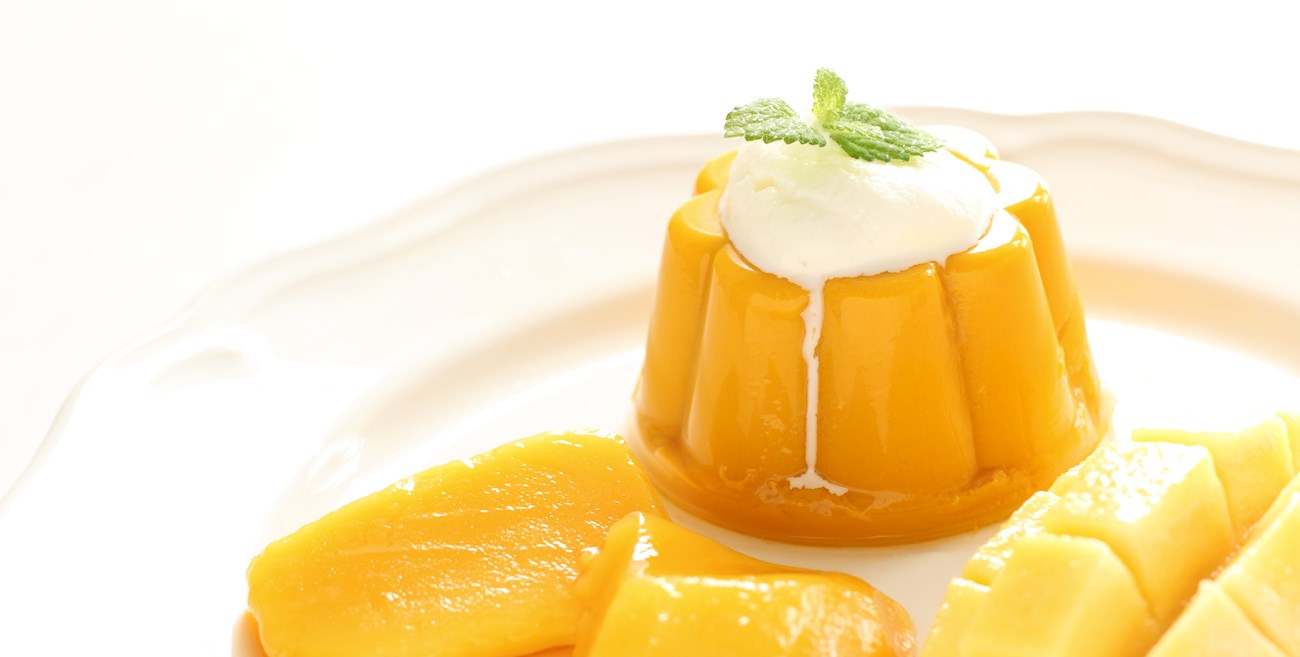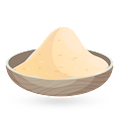One of the most famous Chinese desserts is the classic egg tart, a delicious pastry consisting of a flaky outer shell with a creamy, but firm egg custard in the center. The origin of this traditional Chinese dessert is vague. It is believed that it grew out of Chinese contacts with western culinary traditions, but it is also likely that some form of an egg custard existed before the influence of the West.
Chinese egg tart variety is believed to be a cross between the classic British egg custard, which is much creamier than the Chinese tart, and the famous Portuguese tarts, known as pastéis de nata, which are especially popular in Macau.
MAIN INGREDIENTS
Heuhng mong dung boh deen is a traditional dessert that’s often served as a part of dim sum. This mango pudding is a simple combination of fresh mango, sugar, gelatin, and milk. The mangoes are puréed until smooth, then mixed with hot water, sugar, gelatin, and milk.
The mixture is poured into ramekins or shallow bowls, and it’s then chilled for a few hours before serving. If desired, heuhng mong dung boh deen can be garnished with mint leaves or mango pieces. This dessert is especially popular on hot summer nights due to its refreshing properties.
MAIN INGREDIENTS
The smooth, velvety zhi ma hu or black sesame soup is a variety of Chinese tong sui (lit. sugar water), a dessert soup commonly enjoyed for breakfast, after meals, or served for teatime accompanied by dim sum, the traditional Cantonese bite-sized tea snacks.
Particularly popular in southern China and Hong Kong, this dessert boasts numerous health benefits, thanks to the extremely nutrient black sesame seeds which are rich in vitamin B, magnesium, calcium, manganese, and iron. Zhi ma hu is known to improve digestion, kidney function, prevent gallstones, and reduce blood fat.
MAIN INGREDIENTS
Red bean soup is a classic Chinese soup that is commonly consumed as a dessert, made from red azuki beans, lotus seeds, and tangerine or orange peel. The soup isn't too sweet, and has a subtle sweetness instead, ideal for rounding off a large Chinese meal.
Red bean soup can be served hot in winter or cool during summer. Dates, sago, longan, and coconut milk can all be added in the preparation of this soup, which is considered to be one of the healthiest soups in China because it is rich in vitamins, boosts immunity, and helps against constipation.
Baobing is a simple dessert consisting of finely shaved ice and fresh fruit such as mangoes, litchis, and rambutans. It is usually topped with condensed milk, flavored sugar syrup, mung beans, and peanuts. Baobing is especially popular during the hot summer days in China, Taiwan, and Vietnam, when it can be found on numerous night markets, among tofu and pancakes stands.
The history of baobing can be traced back to more than 1000 years. It was consumed in China as early as the 7th century. Today, the dessert has evolved and can even be found in some Asian restaurants in the United States.
MAIN INGREDIENTS
Chien chang go or thousand layer cake is a classic Chinese dim sum dessert. The dessert consists of numerous layers of sweet egg dough. It’s usually prepared with a combination of eggs, butter, sugar, flour, condensed milk, vanilla, and baking powder.
The batter is layered in a baking tray, and the cake is then baked or steamed until golden. Once chilled, chien chang go is sliced into smaller pieces and served.
MAIN INGREDIENTS
Snow fungus soup is a Chinese delicacy incorporating snow fungus, an edible fungus that grows on trees and has been used since ancient times as a remedy. It is believed that snow fungus can nourish the lungs, and it is especially beneficial for women.
Cooking snow fungus soup is a time-consuming process since it needs to be soaked for at least 4 hours before being cooked with sugar, and ideally, red dates, lotus seeds, gingko nuts, and wolfberries. The soup is served as a dessert and is often prepared for Chinese New Year and other festive occasions.
MAIN INGREDIENTS
Red bean cake is a traditional dessert which incorporates glutinous rice flour and lightly sweetened red bean paste. The base of the cake employs sweet rice flour and eggs, which are then combined with smooth or coarse red bean mixture. Most commonly, red beans are evenly distributed in the cake, but occasionally they can only be used as a filling, coated in the glutinous batter.
Chinese red bean cake is usually steamed or baked in various molds and pans. Because of its custard-like consistency, it is regarded as a special delicacy which is mainly associated with Chinese New Year, when it is commonly prepared and shared among relatives and friends.
Originally a Cantonese specialty, tong sui (lit. sugar water) is a type of sweet soup or a custard-like dessert made with a base of either water or coconut milk. Extremely popular throughout the country, these sugary treats are nowadays found in tong sui shops but also at numerous food stalls, freshly prepared by street vendors.
Tong sui desserts are available in a myriad of different colors and an unlimited selection of flavors, ranging from the simple fruity varieties and tofu puddings to the gaggingly bizarre ones such as guilinggao - powdered tortoise shell jelly or hasma - a sweet soup made with frogs' fallopian tubes!
VARIATIONS OF Tong sui
In its original form, guilinggao was a herbal paste that consisted of the powdered plastron (bottom shell of Golden coin turtle) and a variety of flowers, herbs, spices, roots, and tree barks. Although it was initially used as a health remedy, modern variations are mainly enjoyed as a well-chilled, refreshing jelly dessert.
Since the Golden coin turtle is critically endangered, the original paste is nowadays rarely found and usually comes with a hefty price tag. Many producers opt to use other turtle species, and guilinggao nowadays usually appears as a canned version, or as a powder mix that is easily made into jelly.
TasteAtlas food rankings are based on the ratings of the TasteAtlas audience, with a series of mechanisms that recognize real users and that ignore bot, nationalist or local patriotic ratings, and give additional value to the ratings of users that the system recognizes as knowledgeable. TasteAtlas Rankings should not be seen as the final global conclusion about food. Their purpose is to promote excellent local foods, instill pride in traditional dishes, and arouse curiosity about dishes you haven’t tried.









